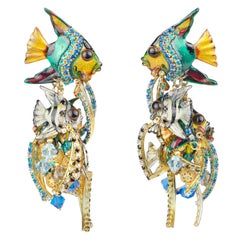Lunch At The Ritz Angelfish
Recent Sales
21st Century and Contemporary American Dangle Earrings
Enamel
Why Enamel Shines in Jewelry Craftsmanship
From vibrant to subtle, elegant to cheeky, vintage and antique enamel jewelry and watches encompass a wide range of colors and styles, and there are almost as many techniques for creating these distinctive pieces.
Enameling is one of the oldest forms of surface decoration, used to add color to jewelry without having to rely on gemstones. Evidence of enameling goes back to ancient Greece. Throughout history, far-flung cultures favored different techniques. For example, cloisonné enamel was popular during the Byzantine Empire, while artisans living in France and Germany in the Middle Ages preferred champlevé. And Art Nouveau jewelry designers favored plique à jour.
At its core, enamel is the fusion of powdered glass to metal, and artists like enameling because it allows them to add a painterly or illustrative quality to their work.
Cloisonné (“cell” in French) is a technique in the creation of enamel jewelry that sees the use of thin wires of fine silver or gold to outline a design, which is then filled with enamel. The piece is subsequently placed in a kiln where the enamel is melted. Cloisonné is distinct because the individual wires remain visible, forming an outline of the motif.
Champlevé (“level field” in French) enamel is almost the opposite of cloisonné. In this technique, depressions in the metal are made by etching, engraving or chiseling, and then layers of enamel are built up until they rise slightly above the surface of the metal. The enamel is then fired and polished.
Guilloché is a technique in which translucent enamel is applied to a piece of metal that has had designs cut into it using a lathe. After the firing, the patterns on the metal become visible. Guilloché was made famous by Peter Carl Fabergé, whose jewelry house used the technique on many of its objets d’art as well as jewelry.
Find antique and vintage enamel rings, bracelets, necklaces and other accessories on 1stDibs.
Finding the Right Dangle-earrings for You
Earrings have a rich, diverse history, and while there are many types of this accessory to choose from, the dangle style is one of the most enduring designs. Today antique and vintage dangle earrings are timeless adornments that can make any outfit instantly more glamorous.
One of the oldest known pairs of dangle earrings was made of jade between 7,500 and 8,200 years ago in Inner Mongolia. Hoop earrings — of which there have been countless variations — are as old as Ancient Mesopotamia, and Ancient Egyptians wore dangle earrings that had sacred symbolism as part of their jewelry practices. In ancient Rome, dangle earrings with pearls and other precious materials were popular.
Dangle earrings vary in length, but they are all designed to cascade off the ears. Some dangle earrings barely fall past the bottom of the earlobe while others fall low enough to graze the shoulders or even fall past them. During the Renaissance period, women wore up-do hairstyles so they could show off their dangle earrings. Even noblemen joined the trend, donning a sole dangle earring adorned with a pearl.
Georgian women preferred heavy girandole earrings that featured candelabra-like arrangements of precious metal and stones. Dangle earrings in the 19th century were simpler, often featuring a single suspended gemstone in a drop-earring style. Going into the 20th century, screw-back earrings and clip-ons became popular, leading to more minimal stud designs. However, dangle earrings have always come back into fashion.
Whether they are made with diamonds, beads or feathers, dangle earrings are statement pieces reflecting the shifting styles over the years. Find the perfect antique and vintage dangle earrings for any occasion on 1stDibs.
